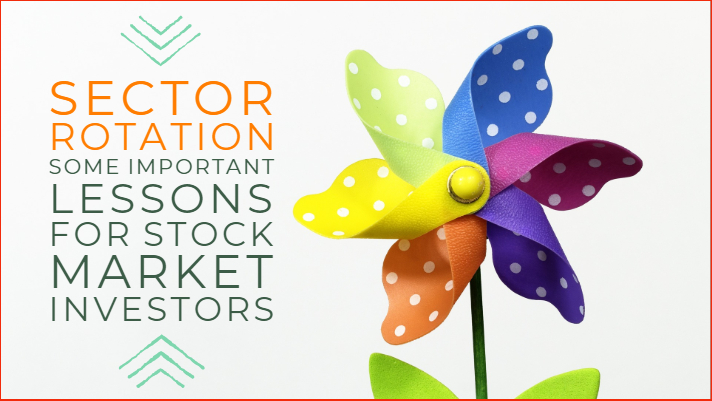All sectors do not perform well at the same time. So is the stocks within. So understanding the concept of sector rotation is among one of the most important factors for your success. Success with your stock market investing. Now let us understand why sector rotation as a concept is important to know for every stock market investor.
Why do we invest money? The answer is straight forward. To reap returns and witness appreciation in our money. However, to get maximum benefits, you need to follow a particular strategy. A particular strategy so that you do your investment at the right time and into the right assets. Everyone is aware of the benefits of equity investing. If done in a disciplined manner, and over a long term, it has immense potential to offer remarkable returns.
While it is important to be consistent with equity investment, it is equally important to have an effective strategy in place. The strategy has to be in harmony with the natural movement of the economy and stocks. Of course your financial objectives too. Another crucial factor that plays an important role in choosing an investment strategy is your risk appetite. The approach towards stock selection must be such that you are able to enjoy high returns at minimal risk. “Sector rotation” is one such smart investment strategy.
What is sector rotation and how does it work?
Sector rotation is an investment strategy that involves shifting your money investments from one sector to another. Any investor adopts this in order to get market-beating returns, on the basis of its performance at each economic cycle.
The theory of sector rotation has been further popularised by Sam Stovall, in his two well-known works- ‘Sector Investing’ and ‘Standard & Poor’s Guide to Sector Investing’.
Firstly, let us understand what a “sector” is?
Sector refers to a bunch of stock of companies operating on similar lines on business. Some examples of sectors are Technology, Energy & Utilities, Banking, Telecom etc. The performance of these sectors depends on the economy.
Furthermore, they are greatly affected by the economic cycles of expansion, peak, contraction, recession and trough. It is a fact that certain stocks earn more profit in a particular cycle than the others. Similarly, certain stocks become less attractive in other cycles.
What is the relationship between the stock market cycle and economic cycle?
Sector rotation strategy is a top-down approach. The philosophy behind sector rotation strategy is that you can earn profits by keeping a tab on the economic cycles. You can also choose to buy or sell stocks based on their performance in each cycle. Let us try to understand the economic cycle in details. As because it is a pivotal factor behind the sector rotation strategy.
A. The typical phases of the economic cycle
There are 5 phases of economic cycle:
1. Expansion: Expansion is a phase where the business activities increase and operate in full momentum. As a result, the Gross Domestic Product also expands at this stage.
2. Peak: Peak is the highest point of the economic cycle when the business activities have reached its ultimate limit. This is the phase between the end of the expansion and the beginning of the contraction cycle.
3. Contraction: The Contraction phase of the economic cycle follows the peak and marks the onset of the business activity decline. The overall economy also starts indicating a downward trend.
4. Recession: The recession in a business cycle is a contraction phase that depicts a general slowdown in the activities intensifies. The macroeconomic indicators like GDP, investment spending, capital expenditure and per capita income reduces and negative indicators such as joblessness, inflation and bankruptcy is on a rise.
5. Trough: Trough marks the end of a recession and the transition phase into expansion. In short, it is the turning point in the economic cycle after the end of a downward spiral of activity.
The stock market, just like the economy, also go through a cycle which consists of four phases. The stock market cycle occurs ahead of the economic cycle because investors anticipate economic impact beforehand. The entire stock market cycle goes lasts somewhere from a week to few years.
B. The typical phases of the stock market cycle
There are four phases of the stock market cycle:
1. Accumulation phase: This phase happens when the market has bottomed and entrepreneurs and value investors see a lot of sense in buying stocks. They feel that the worst is behind them and it is a good phase to accumulate stocks. The market is still subdued and most of the stocks are sold at discounted values. This encourages early movers and investors to buy more of them in the hope of price rise in future.
2. Mark-up phase: This phase is a roller-coaster ride. It is the next stage of the accumulation phase and the markets gain some stability. The prices are at a high and also touch similar lows. At a major number of traders enter the market, the valuations rise. There are higher highs and higher lows. There are more buyers than sellers in the market at this stage.
3. Distribution phase: The stock market cannot be on a high forever, there will be some form of correction after a prolonged positive phase. This is the Distribution phase when the buying activity of the Mark-up phase slows down. There is a considerable number of sellers who enter the market and arrest the upward momentum. The price moves sideways and the buyers and sellers push each other to gain ground.
4. Mark-down phase: This the final phase of the stock market cycle, where sentiment turns slightly negative and there is increased selling activity. Markdown phase also marks the onset of the downtrend in stocks. The stocks cannot hold on to their low valuations and begin their downwards journey. Eventually, the stock prices hit a bottom. This is also the phase before the next accumulation stage.
Broadly speaking, the stock market runs from bulls phase to bear phase and vice-versa. In bull phase market sentiments are positive and every stock performs well. Inversely in bear phase sentiments are poor and stocks performances are in bad shape.
What is the basis of classification of the stock market into sectors?
The stock market classifies stocks in myriad ways. One such way is to group them according to their nature of the business. Companies from the same kind of industries have been grouped together for better understanding and comparison.
These groups are called sectors and are widely used by analysts, investors, and other market participants to analyse companies. Analyzing stocks based on the sector is extremely beneficial. This is so because it helps you to understand how one particular stock performs vis-à-vis the others. Some of the broad sectors that the stocks can be classified into are:
1. Healthcare: This includes stocks of pharmaceutical, medical device manufacturers and leading hospitals listed on the exchange.
2. BFSI: The Banking and Financial Services sector includes stocks of banks, financial institutions and NBFCs.
3. Technology: The stocks of computer hardware manufacturing companies or those involved in the Information Technology business are a part of the Technology sector.
4. FMCG: Fast Moving Consumer Goods (FMCG) or Consumer Packaged Goods (CPG) are some of the products that consumables and sold at a lower per unit cost. As a result, the sales cycle of these products is very short. Non-durable packaged food, cosmetics, toiletries, household care, beverages, etc. are part of the FMCG sector.
Both NSE and BSE have their own sector classifications. You can select stocks for your portfolio from these NSE sector lists and BSE sector lists.
Why sector rotation matters to a stock market investors?
Sector rotation matters to stock market investors because certain sectors perform well in a particular stage of the business cycle, while others do not. If you can assess the possible performance of each sector during each phase of the market cycle, it will be easy to select the stocks. Once that phase of the economic cycle is over, you can shift the invested money to another sector that is suitable for the next market cycle.
One way of grouping the sectors further is based on their behaviour in each of the market cycle phases. The sector which moves in accordance with the cycle is known as the cyclical sectors and the one that is not impacted by market cycle is known as a defensive sector.
Let us try to understand this more closely.
A. What are the defensive sectors?
Sectors such as utility, consumer non-durables especially food or the healthcare segment are from the defensive sector. They are unperturbed by any downturn in the economic cycle. For example, even if there is a recession, people couldn’t stop using utility services like electricity or water, going for health check-ups, consuming medicines or eating food.
These stocks, as their name suggests, defends or protects the portfolio in falling market conditions.
However, there is a catch to this also. Defensive sectors are also not capable of gaining if the market conditions improve. Taking the same example, if the market conditions improve, people will not start using more utility services, eating more food than they can or seeking extra health care. These are the things which people will undertake only as much as they need it.
B. What are the cyclic sectors?
Now, let us look at the cyclical sector. Energy & gas, banking, real estate or capital goods are considered to belong to the cyclical sector. The performance of these sectors is directly related to the economic cycle. If there is a downturn in the market, the banking sector is most impacted.
The movement of global crude oil prices and US Fed interest rate has a direct bearing on the energy sector. There are situations where the overall economic condition of a nation is not favourable. In such instances, the investment sentiment dampens and less of construction work goes on.
Consumers and industries, both, will like to stay away from major purchase decisions. As a result of which the real estate and capital goods sector suffers.
On the flipside, when the recessionary phase is over the economic activity increases. Additionally, the stocks from the cyclical sector tend to witness a good performance. Hence, even though the cyclical sector is impacted because of the volatilities in the stock market, it has immense upside potential as well.
There will be an increased economic activity which will result in increased consumption, more production, more construction and infrastructural development. These factors propel sectors like banking, real estate, capital goods and energy to greater highs.
The sector rotation theory suggests that even at the slightest hint of a favourable economic data, cyclical stocks such as auto, energy, housing, etc. start witnessing increased activity and mark the beginning of the accumulation phase of the stock market cycle.
The anticipation of positive economic data leads to a decline in bond prices which in turn paves way for rising yields. As result, there is a rise in commodity prices which pulls the cyclical sector towards the upward trajectory. The defensive sector takes a back seat during these times.
How sector rotation investment strategy benefits retail investors in India?
The sector rotation strategy has been around for 150 years, however, it has become increasingly popular in recent times. This strategy is a perfect combination of longer-term investing and active management style.
It takes cues from the economic cycles by choosing to invest in sectors that benefit during that particular cycle and avoiding the ones that don’t.
1. Advantages of sector rotation strategies
Sector rotation as strategy is immensely beneficial for long term wealth building because it focusses on broader economic sectors rather than just individual asset classes such as stocks, commodities or bonds.
The best part about the sector rotation strategy is that it enables investors to anticipate the next phase and derive advantage by being an early mover. As investors, you should buy stocks from the sector that is foreseen to perform well in the next economic cycle.
Risk mitigation is a crucial aspect of portfolio management. For effective, risk management, it is essential to have a diversified portfolio. You achieve the best of diversification when you distribute your investment across sectors.
In this way, you share your risk throughout. This is of immense relevance today as investors must park their money in asset classes where they can maximise returns at minimal risk exposure.
2. Disadvantages of sector rotation strategies
Sector rotation strategy has its own benefits. However, there are certain grey areas as well.
The challenge in sector rotation is to select the sectors correctly as well as predict the direction of economic cycles correctly. Another point to understand is that the expectation of a particular sector performing well at a point of economic cycle fructifies in the long-run only.
There are no short-term gains possible here. At the same time, this is also true that a sector has to go through many phases to realise its true potential. While we expect the sector to outperform in the long run, there will also be brief bouts of underperformance as well.
As an investor, you need to be steady during those times. The focus on larger picture and consistency will enable you to ignore these phases and stay resolute. This is a normal phenomenon in equity investing and the market will even out these factors in the long-run.
If you are willing to select stocks on the basis of performing sectors, you need to keep track of them. The easy way to keep track is to scan news. Sector news will help you keep updated on what next type of queries. It will help you keep ahead of any sector rotation on the edge.
About Author

Stock Trading Now trade in ₹9 Per Order or ₹ 999 Per Month Plans.
Future & Options Access F&O contracts with advanced tools for hedging and speculation.
Currency Trading Trade in major currency pairs and manage forex exposure efficiently.
Commodity Trading Diversify Trading with MCX & NCDEX by Trading in Gold, Silver, Base Metals, Energy, and Agri Products.
Margin Trading Funding Boost your buying power with upto 5X, Buy now Pay Later
Algo Trading Back test, Paper Trade your logic & Automate your strategies with low-latency APIs.
Trading View Leverage Trading View charts and indicators integrated into your trading platform.
Advanced Options Trading Execute multi-leg option strategies with precision and insights.
Stock Lending & Borrowing Earn passive income by lending stocks securely through SLB.
Foreign Portfolio Investment Enable NRIs and FPIs to invest in Indian markets with ease and compliance.
IPO Invest in upcoming IPOs online with real-time tracking and instant allotment updates.
Direct Mutual Funds 0% Commissions by investing in more than +3500 Direct Mutual Fund Scheme.
Corporate FDRs Earn fixed returns with low-risk investments in high-rated corporate fixed deposits.
Stocks SIPs Build long-term wealth with systematic investment plans in top-performing stocks.
Bonds & NCDs Access secure, fixed-income investments through government and corporate bond offerings.
Depository Services Safely hold and manage your securities with seamless Demat and DP services with CDSL.
Insurance One-Stop Destination For All Your Insurance Needs. Compare Quotes from Top Insurers & save bigs.
Journey Tracing our growth and milestones over time.
Mission & Vision Guided by purpose, driven by long-term vision.
Why RMoney Platform Smart, reliable platform for all investors' needs.
Management Experienced leadership driving strategic financial excellence.
Credentials Certified expertise with trusted industry recognition.
Press Release Latest company news, updates, and announcements.
Testimonials Real client stories sharing their success journeys.
7 Reasons to Invest Top benefits that make investing with us smart.
SEBI Registered Research Trusted insights backed by SEBI-compliant research.
Our Technology Advanced tools enabling efficient online trading.
Calculators Access a suite of smart tools to plan trades, margins, and returns effectively.
Margin Calculator Instantly check margin requirements for intraday and delivery trades.
MTF Calculator Calculate MTF funding cost upfront to ensure full transparency before placing a trade.
Brokerage Calculator Know your exact brokerage charges before placing any trade.
Market Place Explore curated investment products and trading tools in one convenient hub.
RMoney Gyan Enhance your market knowledge with expert blogs, videos, and tutorials.
Performance Tracker Track our research performance with full transparency using our performance tracker.
Feedback Share your suggestions or concerns to help us improve your experience.
Downloads Access important forms, software, and documents in one place.
Locate Us Find the nearest RMoney branch or service center quickly.
Escalation Matrix Resolve issues faster with our structured support escalation process.
Back Office Log in to view trade reports, ledger, and portfolio statements anytime.
Account Modification Update personal or bank details linked to your trading account.
Fund Transfer Transfer funds instantly online with quick limit updation to your trading account.
Bank Details View our registered bank account details for seamless transactions by NEFT, RTGS or IMPS.
How to Apply IPO Step-by-step guide to apply for IPOs using your trading account.
RMoney Quick Mobile App Trade on-the-go with our all-in-one mobile trading app.
RMoney Quick login Quickly access your trading account through the RMoney Quick web-based trading.
RMoney Rocket Web Version Experience powerful web-based trading with advanced tools for algo traders.
RMoney Rocket Mobile Version Trade anytime, anywhere with our feature-rich mobile trading platform.




















